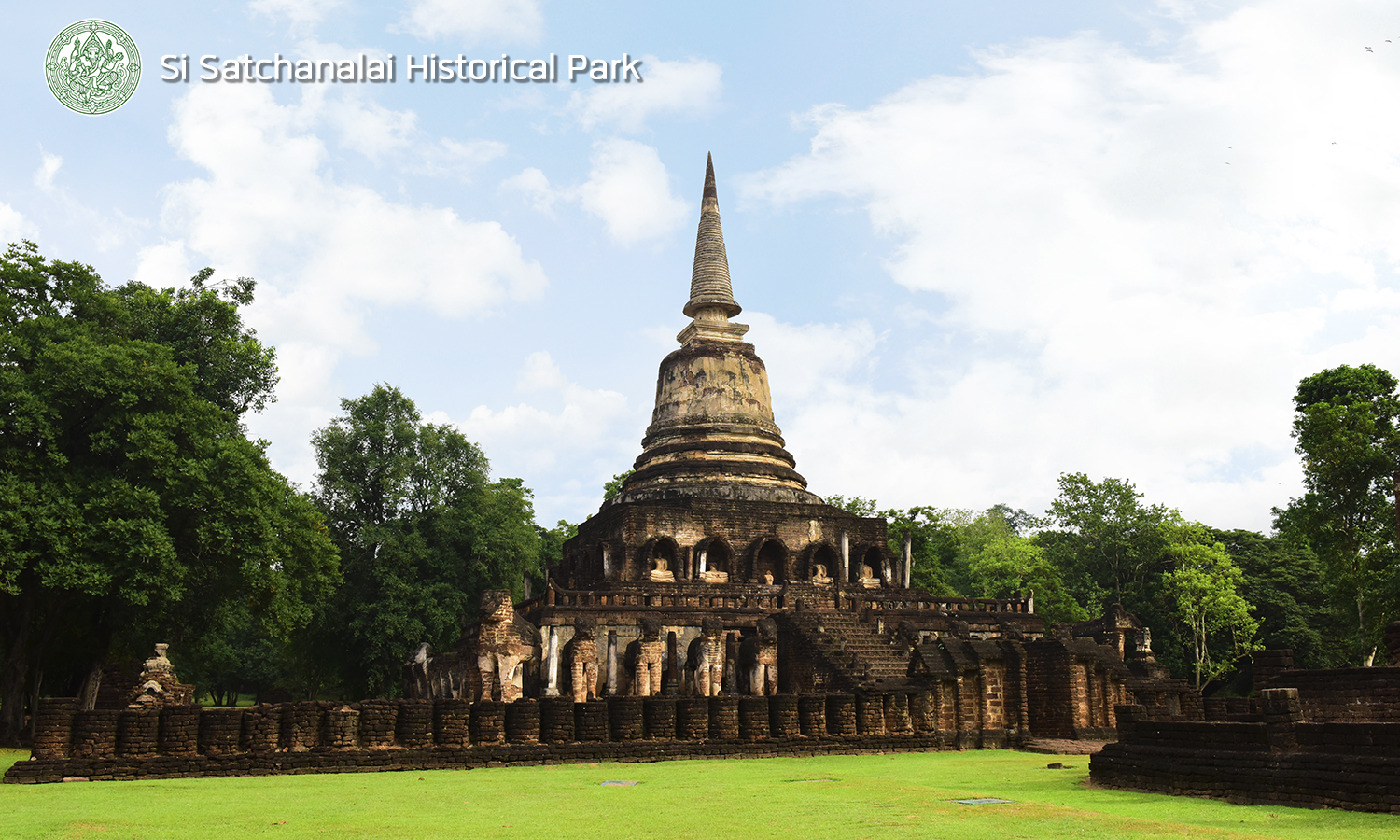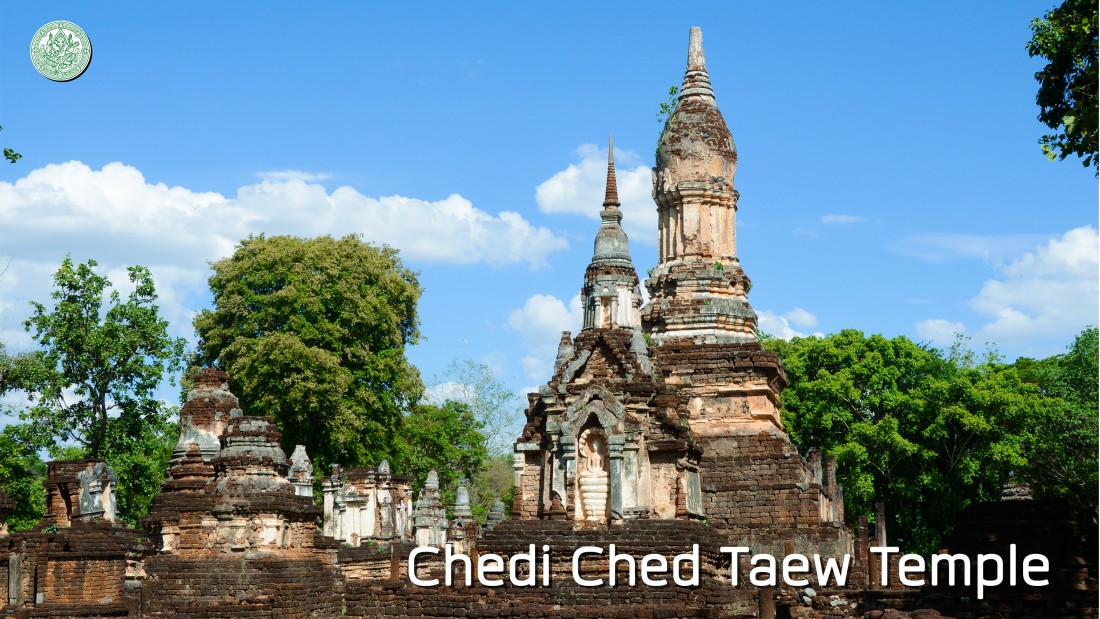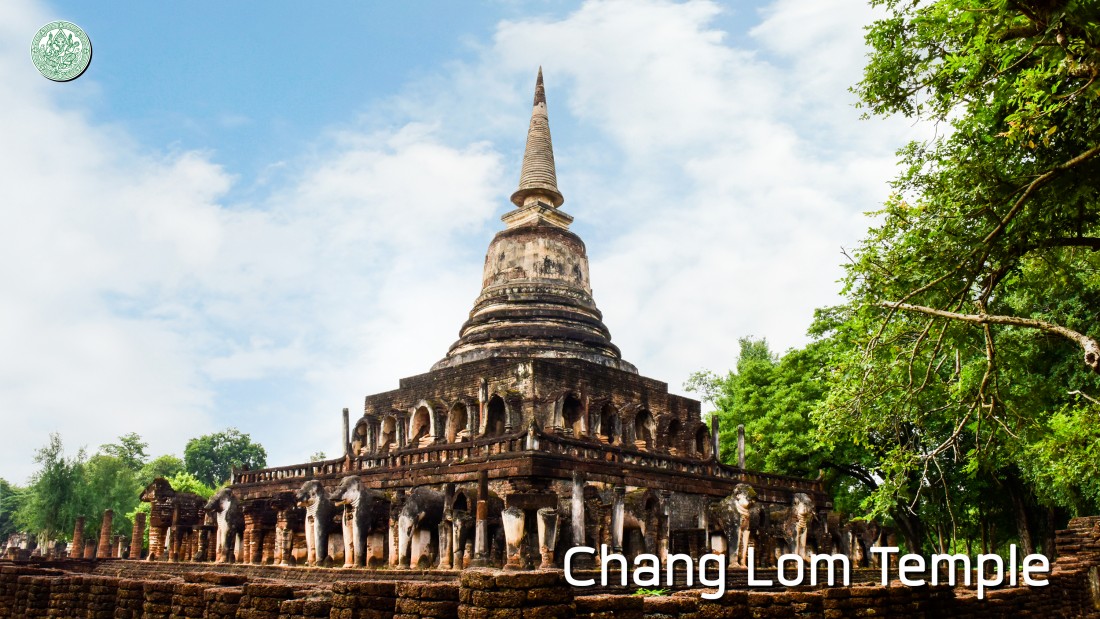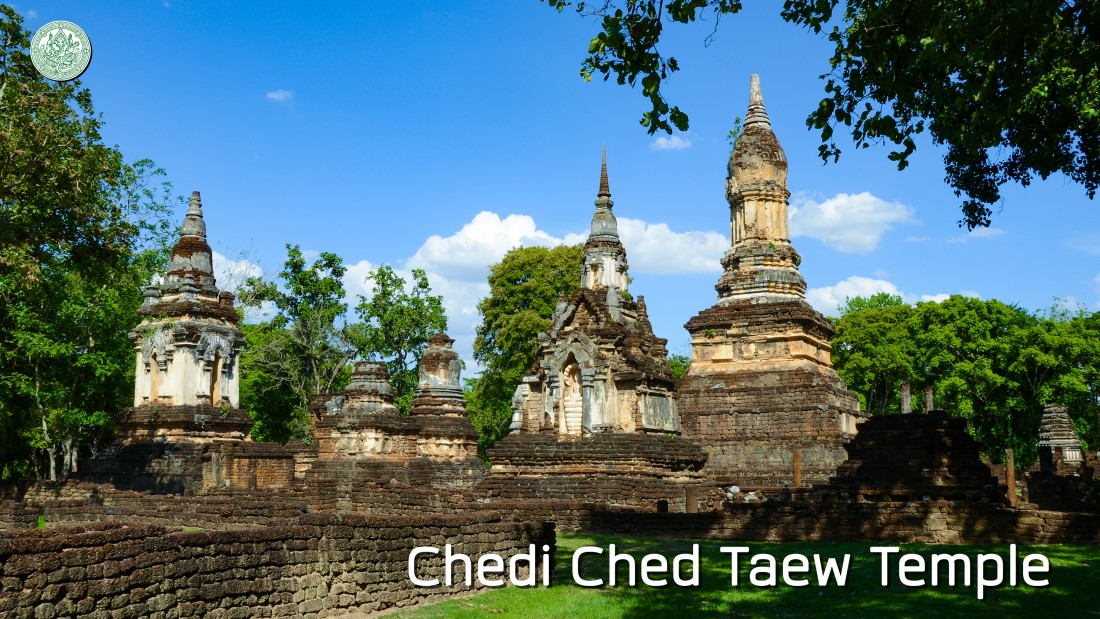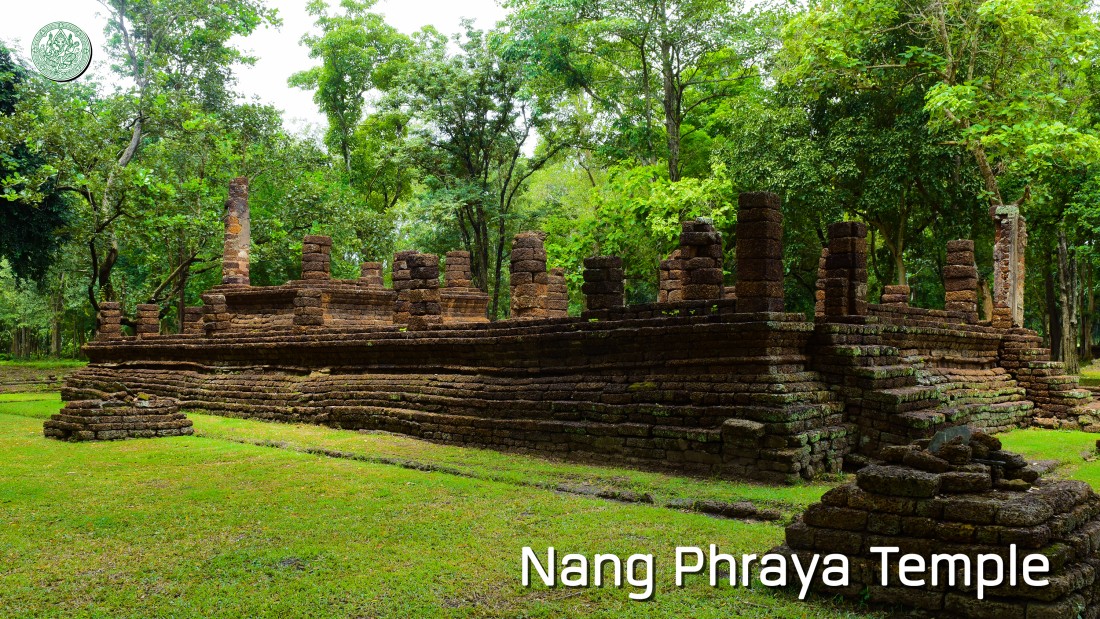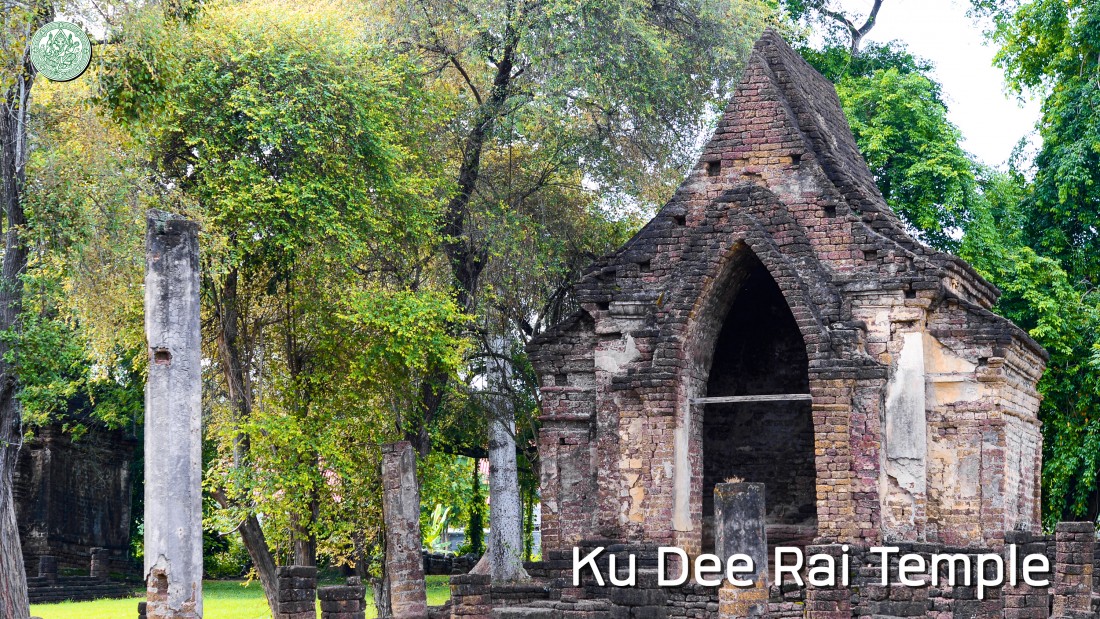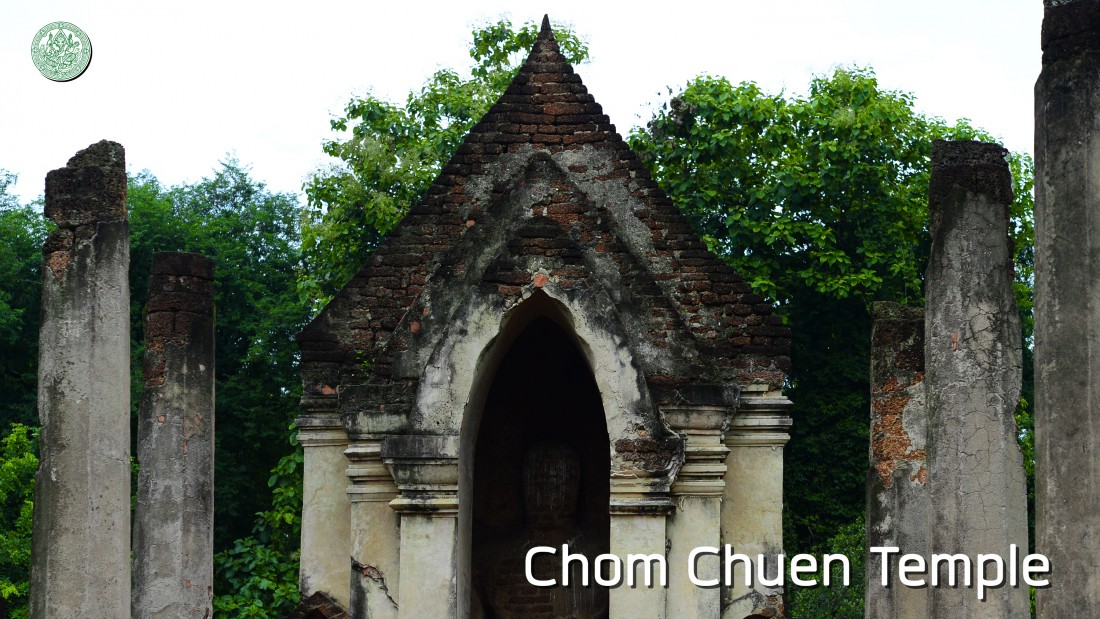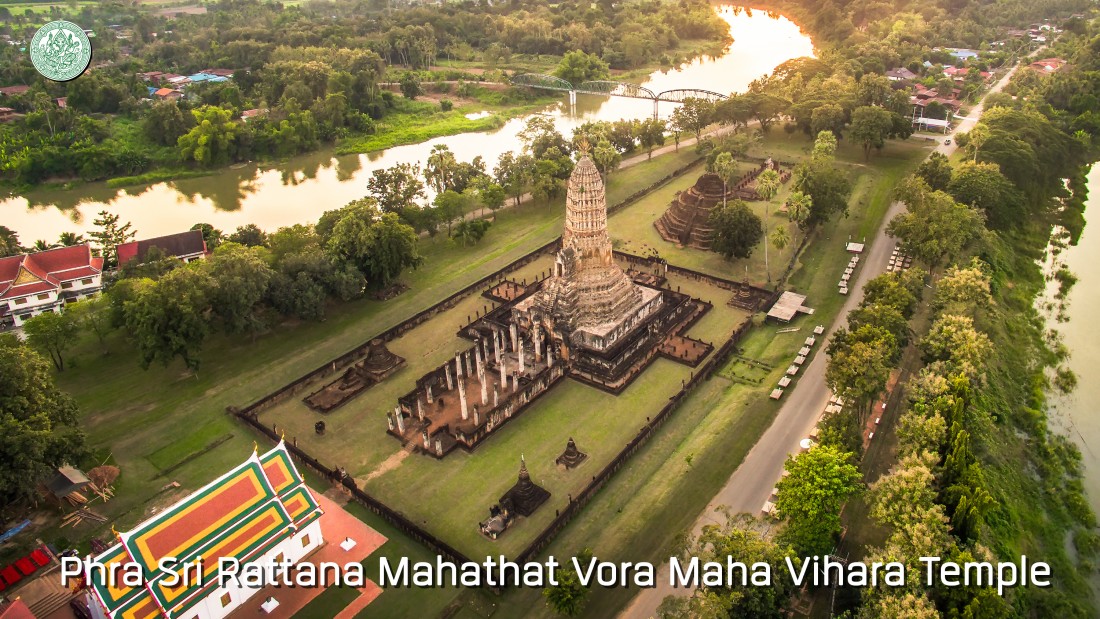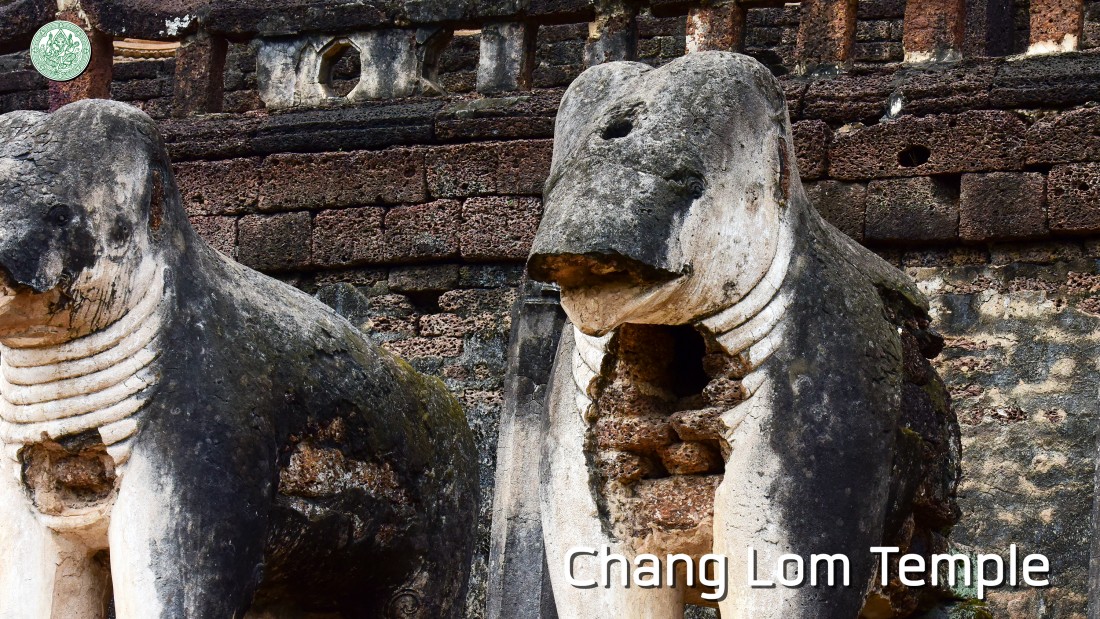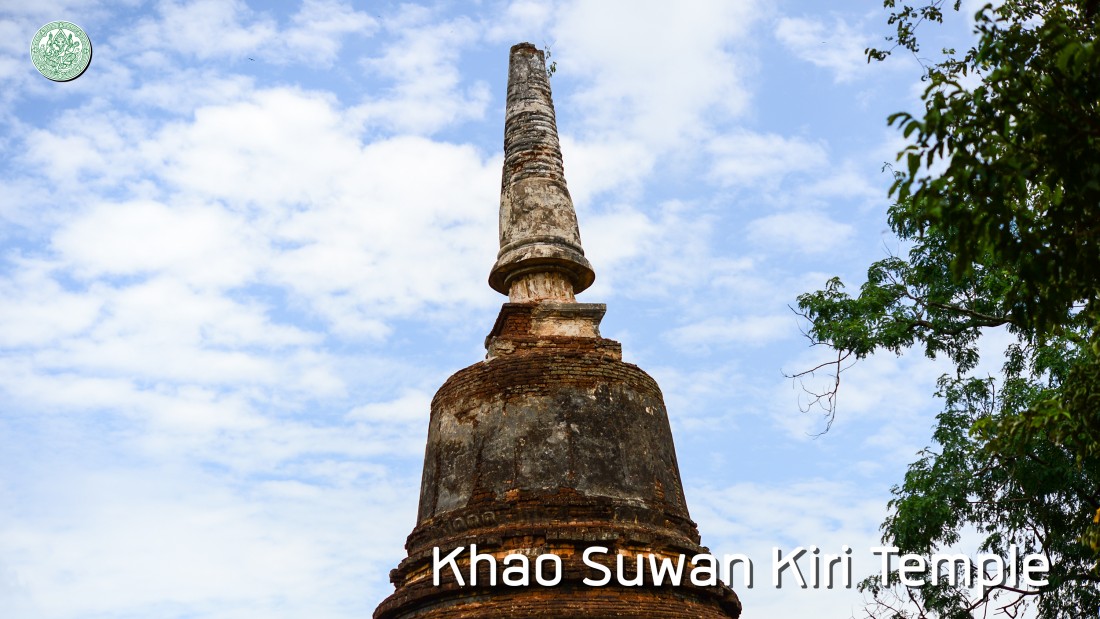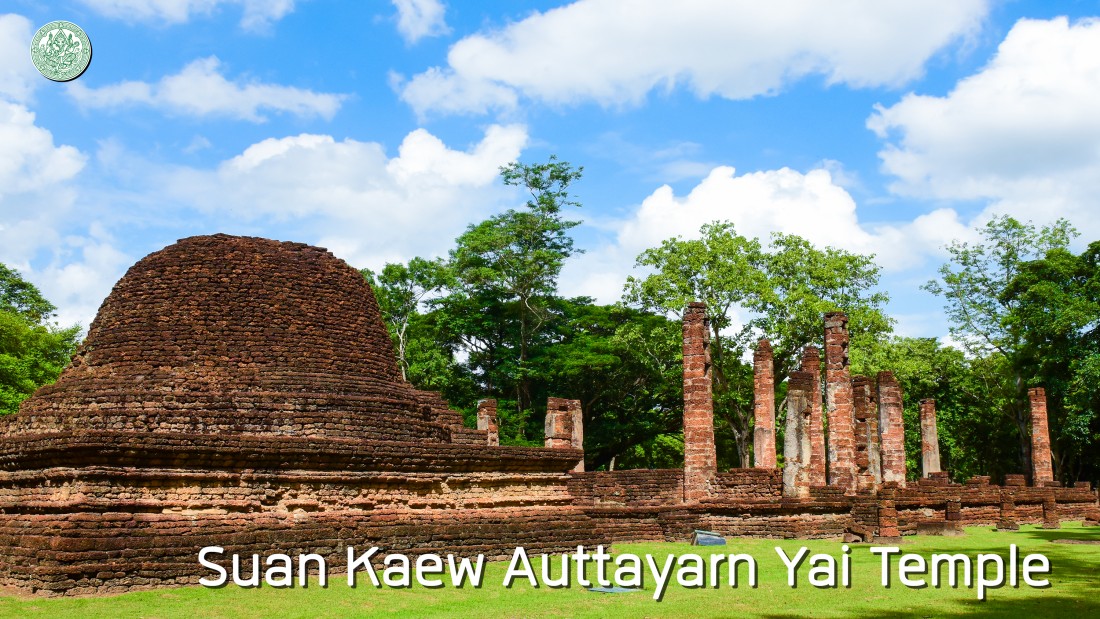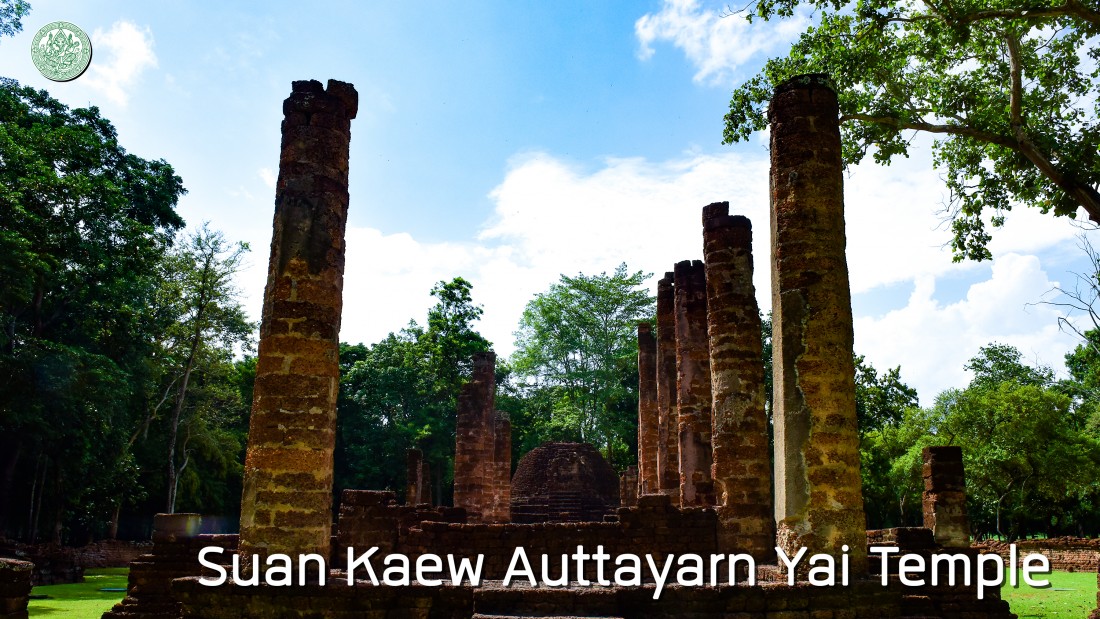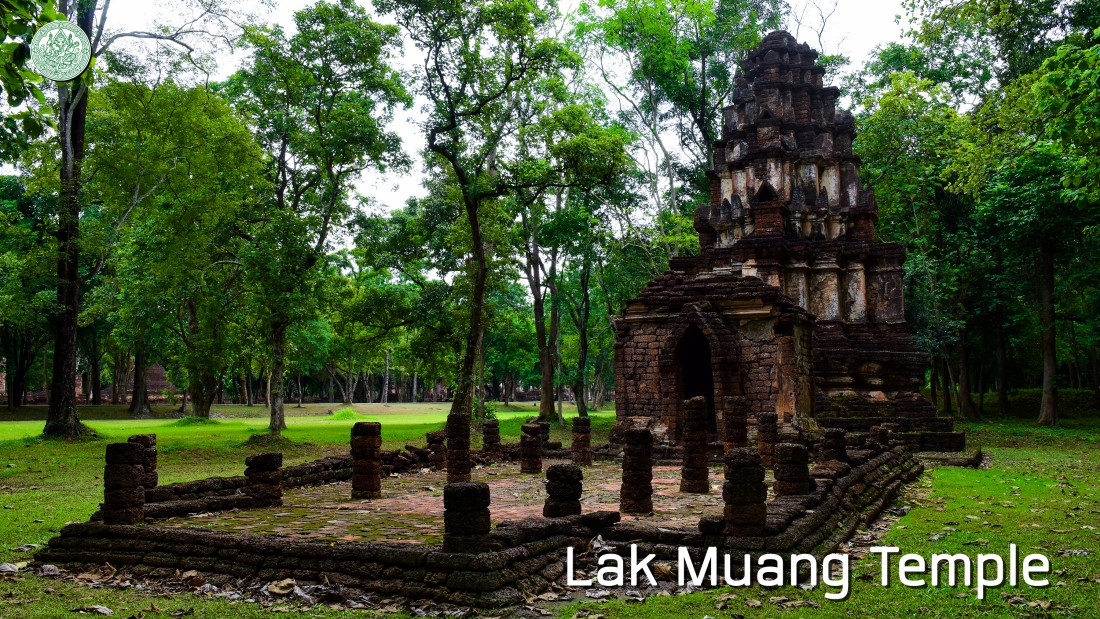Historical Background and Importance
|
The areas of Yom river plain and mountain slopes like Khao Phra Si, Khao Yai and Khao Phra Bat are suitable for settlement said that there are both river basin and mountain slope resulted in a plenty of area and natural fortress for preventing an enemy. Therefore, many evidences of space using of human in the past were found in this area. According to an exploration found the archaeological evidences like polished stone axes at Tumbon Tha Chai, Amphoe Si Satchanalai and the evidence from an archaeological excavation at Wat Chom Chuan demonstrated there is human habitation in the past in the area of Yom river bend or Chaliang city which is the ancient city of Yom river bend along with Sukhothai since the late of prehistory age around the 9th century Buddha or before Sukhothai Period as follows - In the late of prehistory age around the 9th century Buddha, scrap of low quality earthenware, i.e. coarse-textured and burned in quite low temperature were found. - In transitional history to Dvaravati Period around the 10th to 16th century Buddha, the burial of 15 skeletons with iron tools and accessories that dedicated, such as Agate stone beads, glass beads, baked clay bar with grid pattern, etc. were found. - The culture of Lopburi to early Sukhothai Period around, the 17th to 18th century Buddha, there are ancient ruins in square pattern of 2 historical sites that made from brick. When comparable to nearby excavation result found it was the soil layer in the timeline that Khmer Culture was spreading. Then develop to the cultures of Sukhothai to Ayuttaya Period, and Ayuttaya to Rattanakosin Period respectively. The evidence from an exploration and excavation is according to the ancient documents be it China’s annal of Song Dynasty (1503 - 1670) which mentioned to Chern Liang that situated above Lavo Procession or the Yonok Chronicle (the 16th century Buddha) that mentioned to an evacuation to the south to Chaliang Procession. Si Satchanalai city around Sukhothai PeriodChaliang community had developed to Si Satchanalai city, the important city as appeared in the 2nd stone inscription (Wat Sri Chum’s stone inscription, 1912 B.E.) that mentioned to the events before establishing Sukhothai as a capital of Si Satchanalai, said that King Khun Bang Klang Hao went to Bang Yang City for battle with King khun Pha Mueang. Finally, King Khun Bang Klang Hao won and dominated Si Satchanalai City. Sri Satchanalai city around Sukhothai PeriodChaliang Community was developed to Si Satchanalai City, the important city as appeared in the 2nd stone inscription (Wat Sri Chum’s stone inscription, 1912 B.E.) that mentioned to the events before establishing Sukhothai as a capital of Si Satchanalai, said that King Khun Bang Klang Hao went to Bang Yang City for battle with King khun Pha Mueang. Finally, King Khun Bang Klang Hao won and dominated Si Satchanalai City. After King Khun Sri Indraditya established Sukhothai as a capital city in 1793 B.E., Si Satchanalai was one important city as Mueang Luk Luang of Sukhothai. The information in the stone inscription has mentioned to Si Satchanalai as the city that equivalent to Sukhothai which appeared in the 1st stone inscription (King Ramkhamhaeng stone inscription, 1834 B.E.), the name of both cities was simultaneously called “Si Satchanalai Sukhothai”. During the reign of King Khun Sri Indraditya, he pleased to his son that is King Ramkhamhaeng governed Si Satchanalai City. During King Ramkhamhaeng governed Si Satchanalai city, he supported religion with religious place construction (constructed a placing of Buddhist relics) as recorded in the 1st stone inscription (King Ramkhamhaeng stone inscription) that in 1209 S.E. (The year of the pig), King Ramkhamhaeng pleased to dig out Buddha's relics for worship for 1.6 month before embed at the center of Si Satchanalai, overlaid with stupa, and surrounded with Wiang Pha. An another one important event of Si Satchanalai during Sukhothai period is Phra Maha Uparat, governor of Si Satchanalai moved a troops to seize power from Sukhothai in the end of Phaya Lue Thai reign and enthroned as the king in the name of Phra Chao Lithai. The matter of the 4th stone inscription (Wat Pa Mamuang’s inscription, Khmer Language, 1940 B.E.) has mentioned that In 1269 S.E., the year of pig, Phra Bat Kam Ra Deng Un (Phraya Lue Thai), a nephew of Phra Bat Kam Ra Deng Un Sri Ramarat (King Ramkhamhaeng) leaded the legions from Si Satchanalai on Friday, the 5th day of the 7th waxing moon and commanded the force to attack gate and execute enemy. Then, he enthroned Sukhothai instead his dad and granddad in the name of Phra Bat Kam Ra Deng Un Sri Suriyapong Ram Maha Thammarachathirat (Maha Thammaracha I). In the reign of Phraya Lithai, it was a golden age of the regions of Sukhothai included Si Satchanalai, as can be seen from the construction and reconstruction of many religious places and buildings. In the end of the reign of Phra Maha Thammaracha Lithai, Sukhothai was attenuated cause the provinces of Sukhothai were belong to Ayutthaya as the northern provinces which governed by the same governor at first. Sri Satchanalai around Ayutthaya PeriodAfter Sukhothai was totally belong to Ayutthaya in the reign of Maha Thammaracha (1921 B.E.), Ayutthaya by King Borom Trai Lokkanat tried to take control the various provinces of Sukhothai by rearranged a new government regulation which the governors were belong to Ayutthaya directly and the power of old governors are eliminated cause these governors were unsatisfied and deviated to Larn Na Thai, an opponent of Ayutthaya. When Ayutthaya already got the northern provinces, it established Pitsanulok as a north capital and Si Satchanalai as a secondary province which is an important outpost between Ayutthaya and Larn Na. Because Si Satchanalai sought to set it free, not accept to belong to Ayutthaya, the important events were occurred as follow: In 2003 B.E., Phraya Chaliang yielded to Larn Na. The Yonok Chronicle and Ayutthaya Royal Chronicle of Laung Prasert were correspondingly recorded that in 822 C.E. (2003 B.E.), Si Satchanalai’s governor deviated from King Borom Trai Lokkanat of Ayutthaya and yielded to King Tilokarat of Chiang Mai. Ayutthaya Royal Chronicle recorded that In 822 C.E., the year of the Dragon, Phraya Chaliang was planning a rebellion, he gathered the burgher to deviate from King Borom Trai Lokkanat. The Yonok Chronicle particularized that in 822 C.E., Ayutthaya Force went to defeat Phrae City which defensed by Muen Dong Nakhon. When King Tilokarat came to assist causes Ayutthaya Force retreated. In that time, King Tilokarat Force followed Ayutthaya Force to Chaliang city, Phraya Chaliang surrendered to yield and leaded Phra Chao Chiang Mai Force to defeat Fang City, the force situated above the city and plunder about 3 days, but failed then went back to Chaliang City. Then, 832 C.E., the chronicle of Luang Prasert also recorded that Phraya Chaliang leaded King Tilokarat Force to defeat Pitsanulok City and plunder but failed. Therefore, they sent a troop to Kamphaeng Phet and plunder about 7 days and fail again. Therefore, King Tilokarat Force went back to Chiang Mai. The yielding to Chiang Mai of Si Satchanalai’s governor or Phraya Chaliang at that time may be an incident because King Tilokarat Force arrived at the city. During the time, Si Satchanalai belonged to Larn Na for a long time causes Si Satchanalai was called Chiang Chun City as appeared in the Lilit Yuan Phai. It was imprecise that how long Si Satchanalai belong to Chiang Mai, assumed that in the end of the reign of King Tilokarat, Si Satchanalai set it free and belong to Ayutthaya as the same as appeared in Phra Iyakarn Tamnang Nai Taharn Hua Maung, the law that legislated in the reign of King Barom Tilokanart which assigned that Si Satchanalai was a secondary province, governed by Phraya kasetsongkham Ram Rachaseanya Tibhodi Srisatchanalai Abhaipitiyaba Kompahu Phraya Sawankalok. It was the first appeared of the name “Sawankhalok”. Then, there is reconstruction of Si Satchanalai, especially strengthened a fortress, moat, and rampart. Si Satchanalai also called Sawankhalok by Ayutthaya. At first, the local governor was still governed for a while. According to the evidence from the Phra Iyakarn Tamnang Nai Taharn Hua Maung, there is a determination of Si Satchanalai’s governor as Phraya. When the governors of Si Satchanalai and Pichai leaded the regions to assist Khun Phirain Tor Ra Thep eradicated Khun Worrawongsa Thirat, he was promoted to Chao Phraya. Another important event of Si Satchanalai or Sawankalok is the rebellion in the reign of King Naresuan. The cause of this rebellion was recorded in a royal rescript of Ayutthaya Chronicle as follows: Phraya Pichai, an original governor said that King Naresuan was Chao Phra Hongsawadee which is antagonist. Therefore, he thought a rebellion by gathered his family members and townspeople to inform the situation to Phraya Sawankalok. Phraya Sawankalok agreed and contemplated to defeat Pitsanulok, but Luang Pralad, Khun Yok Krabat and Khun Non Nayok disagreed. Thus, Phraya Pichai and Phraya Sawankalok commanded to restrain them. This rebellion of Phraya Pichai and Phraya Sawankalok, King Naresuan severely suppressed by sending troops and commanded by himself. He spent three days to get into Sawankalok. When he got the city, he demanded to tie Phraya Pichai and Phraya Sawankalok, paraded around the force, and killed After this situation, it was not appeared that Si Satchanalai was rebellion to Ayutthaya anymore. The role and importance of Si Satchanalai in Ayutthaya Period, it was the province which is elected for sending troops to assist in war and prevent the north provinces consistently. Si Satchanalai around Thonburi PeriodIn the reign of Phra Chao Krung Thon Buri, when proceeded to suppress Phra Chao Fang (Ruan) rebel and won, he proceeded to Sawankalok for celebrating Phra Prang of Wat Phra Sri Rattana Mahathat Chaliang for 3 days and 3 nights. When the country was strongly gathered, he pleased to establish Sawankalok again in 2313 B.E., but it was abandoned when the seizing of asae wun kyi. Si Satchanalai around Rattanakosin PeriodSomdet Krom Phraya Damrong Rajanubhab described about the provinces house which directly depend on Bangkok that in the past, there are specified in 4 classes called Muang Ek (chief town), Muang Tho (secondary province), Muang Tri (third-class province), and Muang Chattawa (fourth-class province). Si Satchanalai or Sawankalok which is a secondary province in Ayutthaya Period was also promoted as the secondary province in Rattanakosin Period because it used to be Muang Luk Luang and the important outpost. Incidentally, Somdet Krom Phraya Damrong Rajanubhab assumed that for controlling Muang Ek (chief town) as Pitsanulok to aggrandize overly. In the reign of Phra Phutthayotfa Chulalok (King Rama I) of Rattanakosin, he pleased to establish Sawankalok (Si Satchanalai) and Sukhothai again, but the cities were very dilapidated. Therefore, Sawankalok was moved to locate at Wang Mai Khon which far from Muang Kao to the south. Prince Narisara Nuwattiwong recorded about moving of the city in “Chotmai Rayathang Pai Phitsanulok”, a composition of Prince Narisara Nuwattiwong in 2444 B.E. as follows Cause of this city moving, Phraya Sawankalok said that Phraya Sawankalok named Nak is Wang Mai Khon people and also promoted as Phraya, administered at Wang Mai Khon Village as a reason to move city. After moving Sawankhalok to locate at Wang Mai Khon, the townspeople are still stayed at Si Satchanalai as the same. That the organization of administration was moved to the new city, it was an advantage for ancient sites and original building to remain. Then, the administrative organization was rearranged, the provinces were gathered as Monton and the governance depended on Ministry of interior. In the reign of King Chulalongkorn (King Rama V), Sawankalok was gathered with other northern province, such as Pichit, Phitsanulok, Pichai, and Sukhothai to be Monton Phitsanulok. In 2459 B.E., there is the royal command to correct city’s name calling which is called both Muang and Changwat to the same way, Muang (city) was changed to Changwat (province). Therefore, Sawankalok city was changed to Sawankalok Province depend on Monton Pisanulok as the same. When the Thesapibal County system was canceled after the administrative change in 2475 B.E., the administrative organization was rearranged in 2476 B.E. Sawankalok is a province as the same. Until 2482 B.E., there is the degree to change Sawankalok Province to Sukhothai Province. Originally, Sawankalok and Si Satchanalai were specified as Amphoe Sawankhalok and Amphoe Si Satchanalai which depend on Sukhothai Province until now. Historical Background of Archaeological Work and Historical Park PreservationIn B.E.2444, King Chulalongkorn (King Rama V) pleased to build Wat Benchamabophit and assign Prince Narisara Nuwattiwong to plan and design the construction by sculpting the mock of Phra Buddha Chinnarat that enshrined at temple of Wat Phra Sri Rattana Mahathat, Pitsanulok Province. In May, Prince Narisara Nuwattiwong went to inspect Phra Buddha Chinnarat and other ancient sites in the area of Sawankhalok, such as Turiang Kiln and the temples like Wat Chang Lom, Wat Suwankiri Banpot, Wat Khao Phanom Phloeng, Wat Chedi Ched Taew, Wat Somdet Chao Phraya (Wat Nang Phraya), Wat Phra Prang, and Wat Phra Sri Rattana Mahathat Chaliang as he wrote in “Chotmai Rayathang Pai Phitsanulok”, a composition of Prince Narisara Nuwattiwong. In 2450 B.E., King Vajiravudh (King Rama) VI, the crown prince in that time proceeded to Si Satchanalai for exploring ancient sites. In 2470 B.E., Somdet Krom Phraya Damrong Rajanubhab proceeded to Sawankalok (Si Satchanalai) for inspecting historical sites and also issued a license to Mr.Bial Panitkit for relics trading. Cause of this city moving, Phraya Sawankalok said that Phraya Sawankalok named Nak is Wang Mai Khon people and also promoted as Phraya, administered at Wang Mai Khon Village as a reason to move city. After moving Sawankhalok to locate at Wang Mai Khon, the townspeople are still stayed at Si Satchanalai as the same. That the organization of administration was moved to the new city, it was an advantage for ancient sites and original building to remain. Then, the administrative organization was rearranged, the provinces were gathered as Monton and the governance depended on Ministry of interior. In the reign of King Chulalongkorn (King Rama V), Sawankalok was gathered with other northern province, such as Pichit, Phitsanulok, Pichai, and Sukhothai to be Monton Phitsanulok. In 2459 B.E., there is the royal command to correct city’s name calling which is called both Muang and Changwat to the same way, Muang (city) was changed to Changwat (province). Therefore, Sawankalok city was changed to Sawankalok Province depend on Monton Pisanulok as the same. When the Thesapibal County system was canceled after the administrative change in 2475 B.E., the administrative organization was rearranged in 2476 B.E. Sawankalok is a province as the same. Until 2482 B.E., there is the degree to change Sawankalok Province to Sukhothai Province. Originally, Sawankalok and Si Satchanalai were specified as Amphoe Sawankhalok and Amphoe Si Satchanalai which depend on Sukhothai Province until now. Historical Background of Archaeological Work and Historical Park PreservationIn B.E.2444, King Chulalongkorn (King Rama V) pleased to build Wat Benchamabophit and assign Prince Narisara Nuwattiwong to plan and design the construction by sculpting the mock of Phra Buddha Chinnarat that enshrined at temple of Wat Phra Sri Rattana Mahathat, Pitsanulok Province. In May, Prince Narisara Nuwattiwong went to inspect Phra Buddha Chinnarat and other ancient sites in the area of Sawankhalok, such as Turiang Kiln and the temples like Wat Chang Lom, Wat Suwankiri Banpot, Wat Khao Phanom Phloeng, Wat Chedi Ched Taew, Wat Somdet Chao Phraya (Wat Nang Phraya), Wat Phra Prang, and Wat Phra Sri Rattana Mahathat Chaliang as he wrote in “Chotmai Rayathang Pai Phitsanulok”, a composition of Prince Narisara Nuwattiwong. In 2450 B.E., King Vajiravudh (King Rama) VI, the crown prince in that time proceeded to Si Satchanalai for exploring ancient sites. In 2470 B.E., Somdet Krom Phraya Damrong Rajanubhab proceeded to Sawankalok (Si Satchanalai) for inspecting historical sites and also issued a license to Mr.Bial Panitkit for relics trading. In 2485 B.E., the Fine Arts Department has announced the registration of 34 historical sites, such as Wat Chang Lom, Wat Chom Chaun, Wat Chao Chan, Wat Chedi Ched Taew, Wat Suan Kaew Auttayarn Yai, Wat Rahu, etc. At present, all the historical sites are situated in the areas of Si Satchanalai Historical Park. In 2499 B.E., the Fine Arts Department has excavated and reconstructed Wat Phra Sri Rattana Mahathat Chaliang. It was the beginning of preservation and development of the historical sites in ancient Si Satchanalai. In 2500 B.E., the Fine Arts Department has begun to maintain historical sites inside of Si Satchanalai rampart by weeding and inspecting an illegal digging both inside and outside of the ramparts. In 2514 B.E., the Fine Arts Department has excavated and reconstructed the historical sites inside of ancient Si Satchanalai which was completed about 14 historical sites, such as Wat Chang Lom, Wat Chedi Ched Teaw, Wat Suankaew Auttayarn Yai, Wat Suan Kaew Auttayarn Noi, Wat Nang Phraya, etc. In 2525 B.E., the Fine Arts Department has created Si Satchanalai Historical Park Project which is arranged in The 5th National Economic and Social Development Plan (2525 to 2529 B.E.) In 2531 B.E., the Fine Arts Department announced the registration of Si Satchanalai Historical Park with the areas of 45.1472 square kilometers (28,217 Rai) in the administrative division of Tambon Si Satchanalai, Tambon Nong O, Tambon Tha Chai, and Tambon Sara Chit, Amphoe Si Satchanalai, Sukhothai Province. The Fine Arts Department has created the Master Plan of Si Satchanalai Historical Park which is the 7 years long term plan, during 2533 to 2539 B.E. Her Royal Highness Princess Maha Chakri Sirindhorn proceeded to Si Satchanalai Historical Park to preside the Opening Ceremony on 17th May 2533 B.E. In 2534 B.E., Si Satchanalai Historical Park was admired and registered as a world heritage by UNESCO, cooperated with Sukhothai Historical Park and Kamphaeng Phet Historical Park in the name of Historic Town of Sukhothai and Associated Historic Towns. In 2548 B.E., In 2548 B.E., the Fine Arts Department has cooperated with Naresuan University to create master plan of Si Satchanalai Historical Park which is 10 years plan during 2550 to 2559 B.E. Her Royal Highness Princess Maha Chakri Sirindhorn proceeds to Si Satchanalai Historical Park to preside the Opening Ceremony on 17th May 2533 B.E. In 2534 B.E., Satchanalai Historical Park was admired and registered as a world heritage by UNESCO, cooperated with Sukhothai Historical Park and Kamphaeng Phet Historical Park in the name of Historic Town of Sukhothai and Associated Historic Towns. In 2548 B.E., the Fine Arts Department has cooperated with Naresuan University to create master plan of Si Satchanalai Historical Park which is 10 years plan during 2550 to 2559 B.E. Si Satchanalai as a world heritageSi Satchanalai, Sukhothai, and Kamphaeng Phet Historical Park were announced the registration as a world heritage by UNESCO in the name of Historic Town of Sukhothai and Associated Historic Towns in the 15th World Heritage Committee Convention in 2534 B.E. at Carthage city, Tunesia by passing the requirements and criterions of the consideration to be world heritage with criterion 1 and 3 as follows: Criterion1: The Historic Town of Sukhothai and Associated Historic Towns represented a masterpiece which created with intelligent creation Criterion3: The Historic Town of Sukhothai and Associated Towns is representatives of culture or civilization which appeared until the present or disappeared. The World Heritage AreaThere are 45.1472 square kilometers (28,217 Rai) of Si Satchanalai Historical Park including the important historical sites, such as Turiang Kiln Site of Koh Noi Village and Pa Yang Village and the temples as Wat Sri Rattana Mahathat Chaliang, Wat Chedi Ched Taew, Wat Chang Lom, Wat Nang Phraya, Wat Chom Chuan, Wat Chao Chan, etc. |


